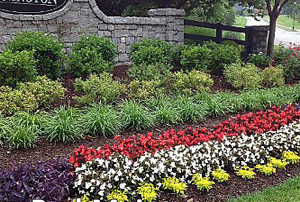Changing Flower Beds For the Summer
Now is the time to change out commercial flower beds around your business for flowers that thrive in hotter temperatures and more intense sunlight. Here's how flower beds should be changed out as part of your commercial landscape maintenance program. Let's start with some flower suggestions. These include delphinium, roses, peony, daylilies, asters, anemones, and iris. Then, choose flowers for their color and fragrance to provide visual interest. Pick flowers from different part of the season that can handle early, mid, and late summer weather. Next, don't just start planting with the new flowers. Instead, you need to prepare the flower bed by removing old perennials and then using weed killer to remove any other type of bed growth. Add new soil and compost to provide nutrients for the flower seeds or flowers that you plan on putting in the flower beds for summer. This is also a good time to change the shape of the flower beds. You don't have to use the traditional straight-line flower beds. Instead, consider curved beds for a unique look. When doing this you can plant the flowers in groups of three or more rather than the straight line found in a vegetable garden style bed. We can help you create beautiful summer flower beds that provide color and a fresh look all season long. Contact us now to find out how we can take care of your commercial landscaping needs. Arrange your garden with an eye to plant color, shape and size as well as time of bloom to give your garden movement and provide new views every time you see it. Arrange plants, shortest to tallest, from front to back or perimeter to center in your bed. When arranging groups, consider the views of your flowerbed from the house and sidewalk as well as the view from up close to it. Use dramatic plants like hostas to brighten shady places; add dramatic punctuation with oriental lilies and commission annuals such as snapdragons to bridge periods when few perennials bloom. Whether your flowerbed is a high-maintenance rose garden or a jumbled cottage plot, it should reflect your personality. You may want shades of one color or a balanced palette of several. Your native garden’s monarda and purple coneflowers attract hummingbirds and butterflies; a moon garden’s white flowers attract nocturnal moths. Declare your concern for the environment by xeriscaping or designing a rain garden, techniques that use native plants to reduce the need for added nutrients and water. Whether a collection of heirloom blooms or the latest hybrid gems, your flowerbed speaks volumes about the gardener who keeps it.

